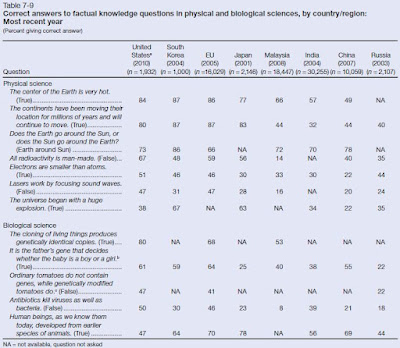These figures come from the National Science Board, which has published a report that contains "a broad base of quantitative information on the U.S. and international science and engineering enterprise."
The full report is on their website and is quite detailed.
This excerpted table contains data showing how students in various countries responded to the same questions, which makes for more direct comparisons:
The tomato genes question is my favorite.
And this table compares scientist vs. public opinions on several STEM topics. It's quite interesting to see by how much the numbers differ in the two columns:
Wednesday, October 10, 2012
Tuesday, June 5, 2012
Venus Transit
By some miracle, we had a brilliant sunny afternoon today for observing the transit of Venus across the sun at Catlin. The larger bright circle is an image of the sun, projected through binoculars onto a paper. The tiny dot on the lower left is Venus, making her way from the lower left to the upper right of the bright circle. There are lots of higher resolution images online, but we had lots of fun watching this in person. It'll take about 6 hours for the transit to finish, but once it's over, you'll have to wait until December 2117 to see the next one!


Monday, February 20, 2012
Tiny Creature Roundup
Anyone else noticed the abundance of small organisms in the news lately? Let's take a tour, starting with the leaf chameleons from Madagascar, which are described as an "extreme case of island dwarfism" at less than 30 mm, full size. A recent PLoS ONE article describes them. Here's a juvenile:

Next, here's a recently discovered terrestrial frog from New Guinea, described as "the smallest known vertebrate species, attaining an average body size of only 7.7 mm" in a different PLoS ONE article. These itty bitty frogs are described as likely prey for scorpions and other large invertebrates.

Speaking of invertebrates, the fairy wasp is one fifth of a millimeter long. Note the scale bar in the photo! Even more interesting is that the adult wasp's nervous system has just a few thousand neurons, most of which do not have nuclei. The juvenile cells seem to accomplish enough protein synthesis before losing their nuclei to last through the wasp's 5 day adult lifespan.

This guy seems giant in comparison, and he'll certainly grow more, but Lil' Drac is an adorable short-tailed fruit bat, abandoned by his mom, but cared for by humans. These videos have a pretty high awww factor.

Videos:
http://www.youtube.com/watch?feature=player_embedded&v=FkeSSdwbnPg
http://www.youtube.com/watch?feature=player_embedded&v=kldBXAB2Kws

Next, here's a recently discovered terrestrial frog from New Guinea, described as "the smallest known vertebrate species, attaining an average body size of only 7.7 mm" in a different PLoS ONE article. These itty bitty frogs are described as likely prey for scorpions and other large invertebrates.
Speaking of invertebrates, the fairy wasp is one fifth of a millimeter long. Note the scale bar in the photo! Even more interesting is that the adult wasp's nervous system has just a few thousand neurons, most of which do not have nuclei. The juvenile cells seem to accomplish enough protein synthesis before losing their nuclei to last through the wasp's 5 day adult lifespan.
This guy seems giant in comparison, and he'll certainly grow more, but Lil' Drac is an adorable short-tailed fruit bat, abandoned by his mom, but cared for by humans. These videos have a pretty high awww factor.
Videos:
http://www.youtube.com/watch?feature=player_embedded&v=FkeSSdwbnPg
http://www.youtube.com/watch?feature=player_embedded&v=kldBXAB2Kws
Subscribe to:
Posts (Atom)


